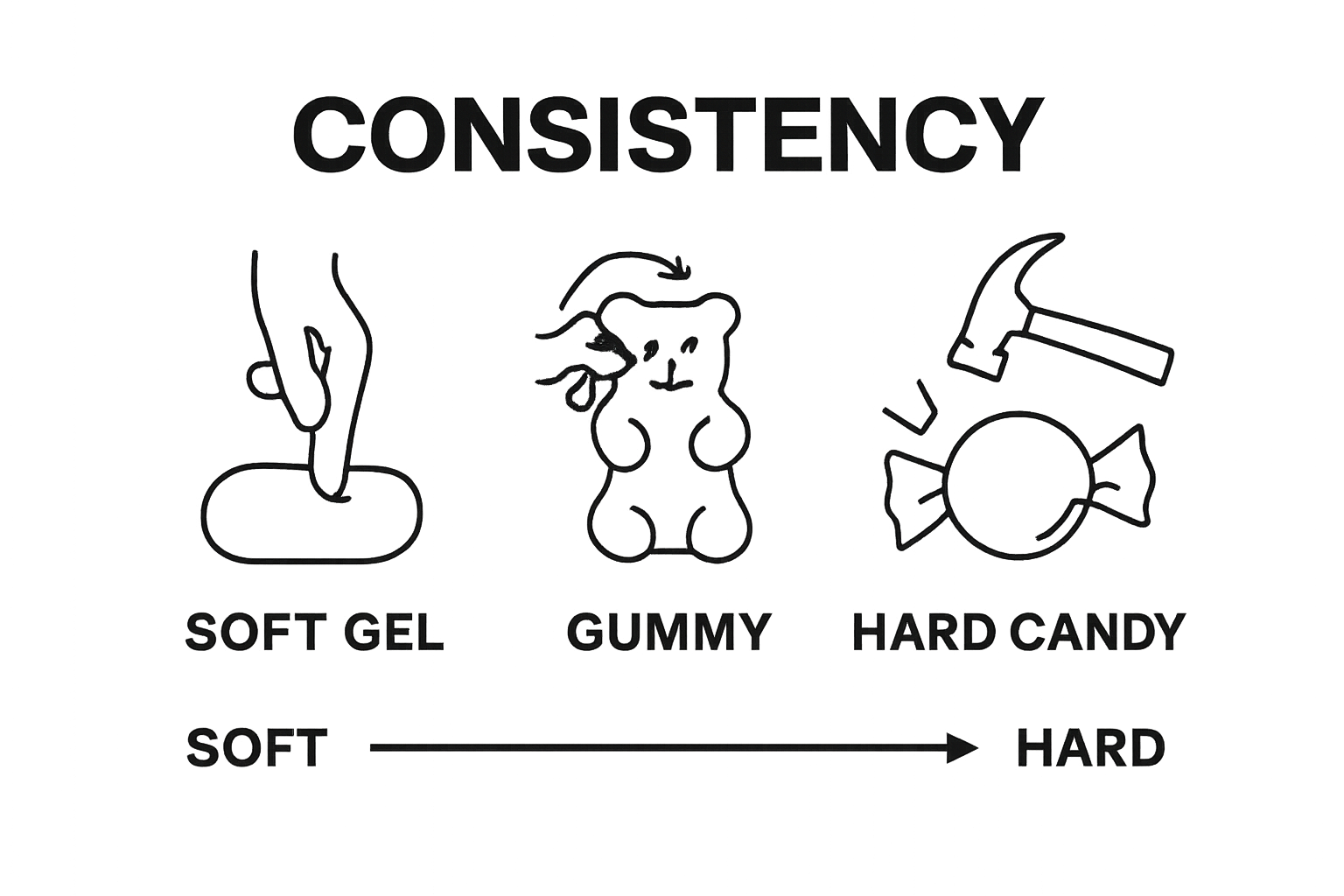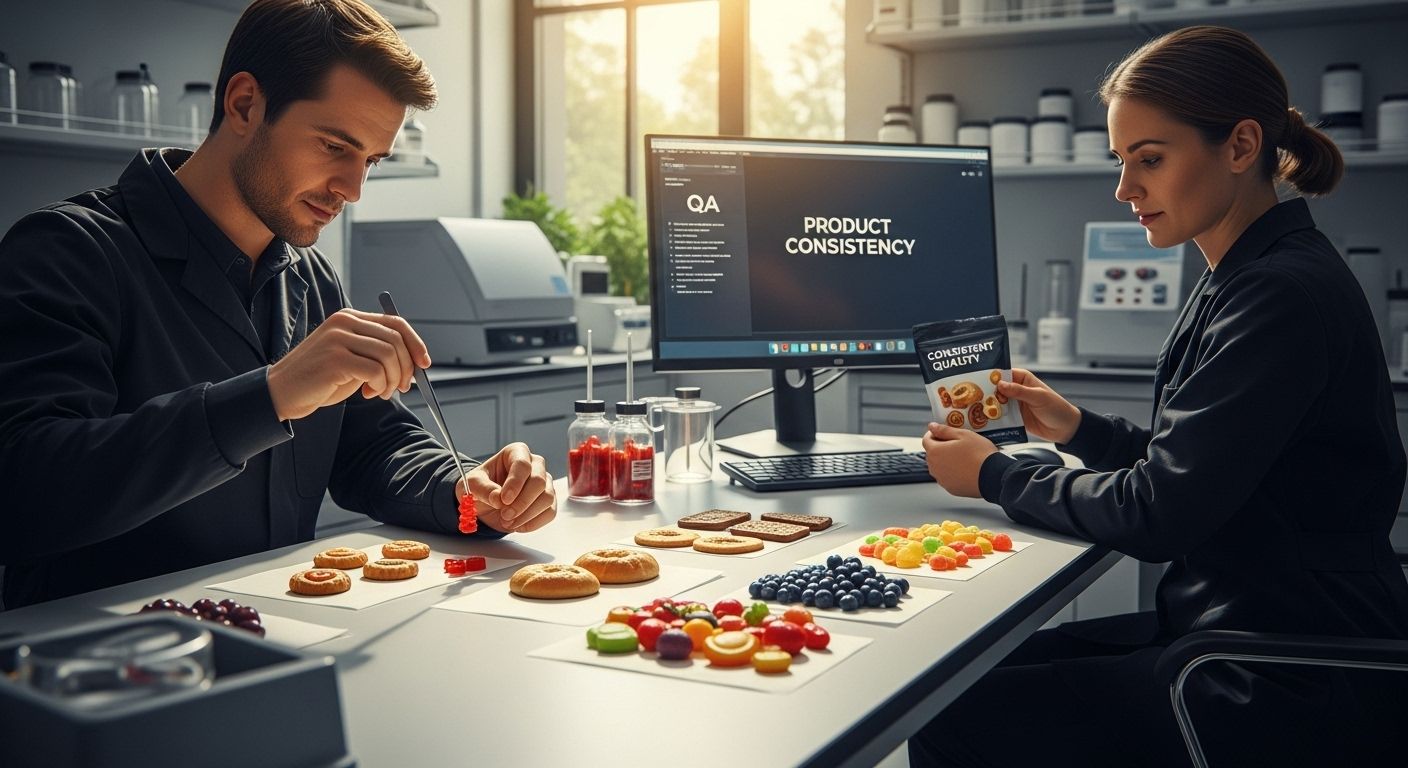Blog
What is Edible Consistency? Understanding Texture in Edibles
Everyone recognizes the pleasure of biting into a perfectly chewy gummy or savoring the crisp edge of a fresh cookie. But most people have no idea that food texture affects more than just taste—it can actually change how fast you eat and how much you enjoy a meal. It turns out that consistency is not just a background detail, but the secret ingredient that shapes how we experience food at every single bite.
Table of Contents
- Defining Edible Consistency: What It Means And Why It Matters
- The Importance Of Texture In Edibles: Flavor And Experience
- How Ingredients Influence Edible Consistency: Key Components At Play
- Real-World Examples Of Edible Consistency: From Gummies To Baked Goods
- Ensuring Safety And Transparency In Edibles: Why Consistency Counts
Quick Summary
| Takeaway | Explanation |
|---|---|
| Texture is vital for edible enjoyment. | The feel of food significantly shapes consumer satisfaction and perception, enhancing the overall eating experience. |
| Ingredients dictate edible consistency. | Specific ingredient choices determine textural properties, influencing sensory experiences when consuming different food products. |
| Texture influences flavor perception. | The way food feels in the mouth greatly affects how flavors are tasted and experienced, altering overall enjoyment. |
| Consistency ensures consumer trust. | Reliable replication of texture across batches guarantees product quality, safety, and consumer satisfaction with edibles. |
| Psychological responses are linked to texture. | Immediate impressions about food quality and safety arise from textural sensations, affecting consumer choices and experiences. |
Defining Edible Consistency: What It Means and Why It Matters
Edible consistency represents the physical characteristics and textural properties of food or consumable products that determine how they feel, interact, and behave when processed in the mouth. Understanding what is edible consistency goes beyond simple taste perception, diving deep into the sensory experience that transforms eating from a mere nutritional activity into a complex, multidimensional interaction.
The Sensory Science Behind Texture
Texture is a critical component of food experience that involves multiple sensory perceptions. When you consume an edible, your mouth performs intricate mechanical assessments through receptors that detect characteristics like softness, firmness, smoothness, and resistance. These sensory inputs communicate crucial information about the product’s quality, freshness, and potential palatability.
According to research published in the National Library of Medicine, food texture profoundly influences oral processing behaviors and even impacts eating rates. Different textural properties can modify how quickly individuals consume food, potentially affecting energy intake and overall eating experience.
Key Components of Edible Consistency
Edible consistency encompasses several fundamental attributes that collectively define a product’s sensory profile:
- Hardness: The force required to compress the food between teeth
- Cohesiveness: How well the food maintains its structural integrity during chewing
- Adhesiveness: The tendency of the food to stick to surfaces like teeth or palate
- Elasticity: The food’s ability to return to its original shape after deformation
These characteristics are not merely academic considerations but practical elements that significantly influence consumer perception, enjoyment, and satisfaction. A perfectly crafted edible with optimal consistency can transform a simple consumption experience into a memorable sensory journey.
Below is a table summarizing the key characteristics of edible consistency, providing concise definitions for each. This makes it easier to understand the terminology used when evaluating texture in edibles.
| Characteristic | Description |
|---|---|
| Hardness | The force required to compress the food between teeth |
| Cohesiveness | How well the food maintains its structural integrity during chewing |
| Adhesiveness | The tendency of the food to stick to surfaces like teeth or palate |
| Elasticity | The food’s ability to return to its original shape after deformation |
| Mouthfeel | How the edible spreads and dissolves across oral surfaces |
| Resistance | The amount of mechanical effort required to break down the food |
| Surface Complexity | Smoothness, graininess, or structured surface characteristics |
The Importance of Texture in Edibles: Flavor and Experience
Texture transcends mere physical properties in edibles, emerging as a critical sensory element that dramatically shapes consumption experience, psychological perception, and overall enjoyment. Understanding how texture interacts with flavor creates a profound narrative about how we experience and interpret food beyond simple gustatory sensations.
Psychological Impact of Textural Sensations
Texture acts as a powerful psychological trigger that communicates complex information about food quality, safety, and desirability. When consuming an edible, your brain rapidly processes textural signals, making instant judgments about palatability and anticipated pleasure. These instantaneous assessments occur through sophisticated neurological pathways that translate mechanical sensations into emotional and cognitive responses.
According to research from Penn State University, individuals possess varying sensitivities to texture, with some people more adept at detecting minute differences in particle sizes and consistency. This neurological variation explains why certain textures might be universally appealing while others trigger immediate rejection.
Texture and Flavor Interaction Dynamics
Texture and flavor are not independent experiences but deeply interconnected sensory phenomena. The way a food feels in your mouth fundamentally influences how you perceive its taste. Smooth textures can enhance subtle flavor notes, while crumbly or grainy consistencies might accentuate bold, robust taste profiles.
Key textural elements that interact with flavor include:
- Mouthfeel: How the edible spreads and dissolves across oral surfaces
- Resistance: The amount of mechanical effort required to break down the food
- Temperature interaction: How texture changes with thermal variations
- Surface complexity: Smoothness, graininess, or structured surface characteristics
These intricate interactions demonstrate that texture is not a passive attribute but an active contributor to the holistic gustatory experience, transforming eating from a mere nutritional activity into a rich, multisensory journey.
How Ingredients Influence Edible Consistency: Key Components at Play
Ingredients serve as architectural building blocks that fundamentally determine an edible’s textural profile, acting as molecular engineers that shape sensory experience through complex interactions. The strategic selection and combination of ingredients transform raw components into a cohesive, intentional sensory experience that goes far beyond simple nutritional considerations.
Molecular Interactions and Structural Dynamics
At the microscopic level, ingredients interact through intricate molecular mechanisms that directly influence consistency. Proteins, starches, fibers, and hydrocolloids create sophisticated networks that determine how an edible will behave when processed. These molecular interactions establish critical textural characteristics like elasticity, viscosity, and structural integrity.
According to research examining food rheology, the physical properties of ingredients can dramatically modify eating rates and energy intake. Harder or more complex ingredient compositions require more mechanical processing, potentially slowing consumption and altering the overall sensory experience.
Critical Ingredient Categories and Their Textural Contributions
Different ingredient categories play unique roles in shaping edible consistency:
- Binding Agents: Create structural cohesion and prevent crumbling
- Moisture Regulators: Control water distribution and prevent separation
- Structural Proteins: Provide mechanical strength and elasticity
- Hydrocolloids: Enhance smoothness and prevent ingredient separation
The precise balance and interaction of these ingredient categories determine whether an edible will be soft and yielding or firm and resistant. Professional formulators understand that consistency is not about individual ingredients but their sophisticated, carefully orchestrated combination.
Ultimately, ingredient selection represents a nuanced art form where scientific understanding meets culinary creativity, transforming simple components into a complex sensory experience that engages multiple layers of perception.
The following table outlines critical ingredient categories in edibles and their specific contributions to texture and overall consistency. This helps illustrate how formulation choices directly affect the final sensory experience.
| Ingredient Category | Textural Contribution |
|---|---|
| Binding Agents | Create structural cohesion, prevent crumbling |
| Moisture Regulators | Control water distribution, prevent separation |
| Structural Proteins | Provide mechanical strength and elasticity |
| Hydrocolloids | Enhance smoothness, prevent ingredient separation |
| Starches/Fibers | Add bulk, modify firmness and chewiness |
| Sugars | Influence softness and crystalline structure |
| Fats/Oils | Affect mouthfeel, tenderness, and richness |
Real-World Examples of Edible Consistency: From Gummies to Baked Goods
Edible consistency transforms theoretical concepts into tangible sensory experiences across various food categories. Different products showcase unique textural characteristics that reflect sophisticated ingredient interactions and manufacturing techniques, turning scientific principles into delightful consumable experiences.
Gummies: The Quintessential Consistency Showcase
Gummies represent a perfect laboratory for understanding edible consistency, embodying complex textural engineering. These chewy confections require precise balance between gelatin or pectin concentrations, sugar content, and moisture levels to achieve their signature bounce and resilience. Explore our Raspberry Whirl Disco Magic Mushroom Gummies to witness how meticulous formulation creates an ideal texture that provides both structural integrity and pleasant mouthfeel.
According to research examining food texture, the consistency of products like gummies involves measuring parameters such as chewiness, firmness, and elasticity. These metrics determine not just the physical experience but also consumer acceptance and enjoyment.

Textural Diversity in Edible Products
Different edible categories demonstrate remarkable textural variations:
- Soft Gels: Smooth, uniform texture with immediate dissolution
- Hard Candies: Rigid structure with slow, gradual breakdown
- Baked Goods: Layered textures combining crisp exteriors with tender interiors
- Fruit-Based Edibles: Complex textures mimicking natural fruit characteristics
Each product category requires unique formulation strategies to achieve desired consistency. Manufacturers manipulate ingredient ratios, processing temperatures, and cooling techniques to engineer precise textural experiences that align with consumer expectations.
This table compares the textural characteristics of common edible product categories, making it easier to see how texture can vary widely across different types of edibles and baked goods.
| Edible Category | Texture Profile Description |
|---|---|
| Gummies | Chewy, elastic, resilient |
| Soft Gels | Smooth, uniform, immediate dissolution |
| Hard Candies | Rigid, hard, slow breakdown |
| Baked Goods | Layered, crisp exterior with tender or moist interior |
| Fruit-Based Edibles | Complex, mimics real fruit (fibrous, juicy, sometimes chewy) |
| Chocolates | Smooth, melts gradually, creamy |
Understanding edible consistency is not just about scientific analysis but about creating memorable sensory journeys that transform simple ingredients into extraordinary culinary experiences.
Ensuring Safety and Transparency in Edibles: Why Consistency Counts
Consistency in edibles represents far more than a sensory experience it is a critical marker of product quality, safety, and consumer trust. The precise replication of texture, composition, and performance across batches ensures that consumers receive a predictable, reliable product that meets rigorous standards of manufacturing excellence.
Quality Control Through Consistent Manufacturing
Manufacturing consistency demands meticulous attention to ingredient selection, processing parameters, and quality verification protocols. Each production batch must demonstrate near-identical characteristics to guarantee consumer safety and product reliability. Learn more about our quality verification process and understand how we maintain exceptional standards across our product lines.
According to research from the National Agricultural Library, developing consistent edible products involves creating protective barriers that reduce oxidation and microbial growth. These technical strategies directly contribute to maintaining product integrity and consumer safety.
Critical Safety Parameters in Edible Production
Ensuring safety through consistency involves monitoring multiple critical parameters:
- Ingredient Homogeneity: Uniform distribution of active compounds
- Microbial Testing: Verifying absence of harmful microorganisms
- Dosage Precision: Consistent concentration of active ingredients
- Stability Assessment: Evaluating product performance under various environmental conditions
Transparency in edible production means providing consumers with comprehensive information about manufacturing processes, ingredient sourcing, and quality control mechanisms. This approach transforms product consistency from a technical requirement into a fundamental commitment to consumer trust and safety.

Taste the Science of Consistency With Every Bite
Are you searching for edibles that deliver the exact texture and consistency you expect? The article you just read highlights just how critical edible consistency is for both safety and enjoyment. If you’ve ever worried about gritty textures, inconsistent dosing, or unclear ingredients, you are not alone. Many consumers want mouthwatering flavors paired with batch-tested reliability and smooth, satisfying mouthfeel. At Disco Magic Mushrooms, we put these principles into every product.

Discover our range of expertly-formulated Magic Mushroom Gummies and experience mouthfeel that is as precise as our dosing. Each batch undergoes independent lab testing for consistency and ingredient transparency. Looking for safe consumption, clear labels, and top-grade flavor profiles? Visit Disco Magic Mushrooms to choose your next edible with complete confidence. Act now to elevate your edible experience with the smoothest, most reliable textures available.
Frequently Asked Questions
What is edible consistency?
Edible consistency refers to the physical characteristics and textural properties of food that determine how it feels and behaves when processed in the mouth, enhancing the overall sensory experience of eating.
Why is texture important in edibles?
Texture significantly influences the consumption experience by affecting how flavors are perceived, impacting psychological responses, and shaping consumer enjoyment. Different textures can enhance or detract from the overall flavor experience.
How do ingredients affect the texture of edibles?
Ingredients determine the textural profile of edibles through molecular interactions. Components like proteins, starches, and hydrocolloids work together to create specific characteristics such as elasticity, cohesiveness, and smoothness.
What are the key characteristics that define edible consistency?
Key characteristics of edible consistency include hardness, cohesiveness, adhesiveness, and elasticity, which collectively influence how an edible is experienced during consumption.
Recommended
- DISCO MUSHROOM GUMMIES
- MELON MEDLEY DISCO MAGIC MUSHROOM GUMMIES – DISCO MAGIC MUSHROOMS
- SOUR APPLE DISCO MAGIC MUSHROOM GUMMIES – DISCO MAGIC MUSHROOMS
- RASPBERRY WHIRL DISCO MAGIC MUSHROOM GUMMIES – DISCO MAGIC MUSHROOMS
Article generated by BabyLoveGrowth

